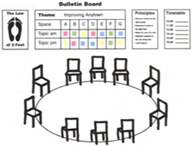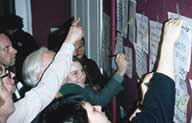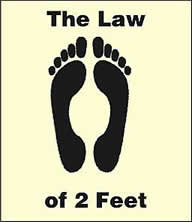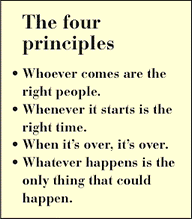Community Planning: Methods
Open space workshop
- description
- more detail
- more pictures
Open space workshops provide a highly democratic framework for enabling any group of people to create their own programme of discussions on almost any theme without much preparation. They are particularly useful for dealing with general policy issues, for generating enthusiasm and for dealing with urgent issues needing quick action.
A theme, venue and time are determined and publicised by the organisers.
Participants start by sitting in a circle and decide themselves on the issues to discuss, using a simple procedure (see workshop format in second tab) usually guided by a facilitator.
Workshop sessions are self managed by the participants within a framework of simple principles and 'laws' (see third tab). Each workshop session develops a list of actions required and who should take them.
A theme, venue and time are determined and publicised by the organisers.
Participants start by sitting in a circle and decide themselves on the issues to discuss, using a simple procedure (see workshop format in second tab) usually guided by a facilitator.
Workshop sessions are self managed by the participants within a framework of simple principles and 'laws' (see third tab). Each workshop session develops a list of actions required and who should take them.
Photocredits
The Prince of Wales's Institute of Architecture, London, UK, 1997, Nick Wates
The Prince of Wales's Institute of Architecture, London, UK, 1997, Nick Wates

Starting point
Circle of chairs; bulletin board with workshop locations identified; timetable; posters of 'principles' and 'laws'.

Creating an agenda
Participants sign up for which issues they want to discuss in workshop groups, selecting from the menu created by the participants themselves. Reports from the workshops can later be posted on the same bulletin board.
Tips
- The framework is flexible and can easily be adapted by the facilitators or participants. The 'principles', 'laws' and timetable can be adjusted to take account of local conditions and experience.
- Good facilitation is important for setting up the workshop and getting people started. Once up and running, the facilitator can fade into the background.
Costs
- Main costs: venue, refreshments, stationery (A4 paper, large marker pens, Post-it notes, flipchart paper and masking tape) and facilitator's fee (if any).
Open space workshop format
For minimum length session. For longer events, workshops sessions and open sessions (steps 5 & 6) are repeated.
For minimum length session. For longer events, workshops sessions and open sessions (steps 5 & 6) are repeated.
- Preparation
Set up the space as shown in the Starting point sketch (see tab 1) - Introduction
Participants sit in a circle. Facilitator explains purpose and procedure. (10 mins) - Opening circle declaring issues
Participants are invited to identify issues they want to convene workshops on. People write their issue on a sheet of paper with their name, read it out ('My name is.... My issue is ......') and place the sheet on the bulletin board in a suitable workshop slot. Several issues can be dealt with in one workshop if there are more issues than slots. (15 mins) - Signing up
Everyone gathers round the bulletin board and signs up for the workshops they wish to take part in. (15 mins) - Workshop sessions
Sessions take place. Results are recorded, usually as a simple list of actions required and by whom for each issue. These are posted on the bulletin board. (60 mins) - Open session
General debate in a circle after refreshment break. (30 mins) - Final plenary circle
Participants make any final statements they wish. (15 mins) - Report circulated
Preferably at the end of the event or the next day. Needs only to contain the action points and responsibility for them.
Running time: 2.5 hours 3 days
Ideal numbers: 20 to 500.
Inspiration
-
"It was fantastic. I felt really heard. I learnt lots I didn't know about my local area, and we created some brilliant ideas of what to do. I wish I had brought more of my friends."
Thanks: Romy Shovelton, Adele Wilter

